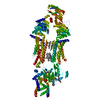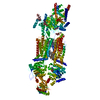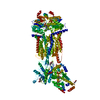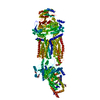+ Open data
Open data
- Basic information
Basic information
| Entry | Database: PDB / ID: 8eeb | ||||||
|---|---|---|---|---|---|---|---|
| Title | Cryo-EM structure of human ABCA7 in Digitonin | ||||||
 Components Components | Phospholipid-transporting ATPase ABCA7 | ||||||
 Keywords Keywords | TRANSPORT PROTEIN / ABC transporter / Lipid Transporter / ABC exporter | ||||||
| Function / homology |  Function and homology information Function and homology informationapolipoprotein A-I receptor activity / plasma membrane raft organization / positive regulation of engulfment of apoptotic cell / negative regulation of amyloid precursor protein biosynthetic process / phospholipid transporter activity / ABC transporters in lipid homeostasis / floppase activity / phosphatidylserine floppase activity / positive regulation of phospholipid efflux / amyloid-beta clearance by cellular catabolic process ...apolipoprotein A-I receptor activity / plasma membrane raft organization / positive regulation of engulfment of apoptotic cell / negative regulation of amyloid precursor protein biosynthetic process / phospholipid transporter activity / ABC transporters in lipid homeostasis / floppase activity / phosphatidylserine floppase activity / positive regulation of phospholipid efflux / amyloid-beta clearance by cellular catabolic process / phospholipid efflux / phosphatidylcholine floppase activity / positive regulation of amyloid-beta clearance / high-density lipoprotein particle assembly / negative regulation of endocytosis / positive regulation of protein localization to cell surface / P-type phospholipid transporter / apolipoprotein A-I-mediated signaling pathway / regulation of amyloid precursor protein catabolic process / cholesterol efflux / phospholipid translocation / amyloid-beta formation / negative regulation of PERK-mediated unfolded protein response / negative regulation of amyloid-beta formation / regulation of lipid metabolic process / glial cell projection / ATPase-coupled transmembrane transporter activity / positive regulation of cholesterol efflux / protein localization to nucleus / phagocytosis / ABC-type transporter activity / phagocytic cup / negative regulation of MAPK cascade / positive regulation of phagocytosis / visual learning / memory / ruffle membrane / cell junction / early endosome membrane / positive regulation of ERK1 and ERK2 cascade / Golgi membrane / intracellular membrane-bounded organelle / cell surface / endoplasmic reticulum / Golgi apparatus / ATP hydrolysis activity / ATP binding / plasma membrane Similarity search - Function | ||||||
| Biological species |  Homo sapiens (human) Homo sapiens (human) | ||||||
| Method | ELECTRON MICROSCOPY / single particle reconstruction / cryo EM / Resolution: 3.9 Å | ||||||
 Authors Authors | Alam, A. / Le, L.T.M. / Thompson, J.R. | ||||||
| Funding support |  United States, 1items United States, 1items
| ||||||
 Citation Citation |  Journal: EMBO J / Year: 2023 Journal: EMBO J / Year: 2023Title: Cryo-EM structures of human ABCA7 provide insights into its phospholipid translocation mechanisms. Authors: Le Thi My Le / James Robert Thompson / Sepehr Dehghani-Ghahnaviyeh / Shashank Pant / Phuoc Xuan Dang / Jarrod Bradley French / Takahisa Kanikeyo / Emad Tajkhorshid / Amer Alam /  Abstract: Phospholipid extrusion by ABC subfamily A (ABCA) exporters is central to cellular physiology, although the specifics of the underlying substrate interactions and transport mechanisms remain poorly ...Phospholipid extrusion by ABC subfamily A (ABCA) exporters is central to cellular physiology, although the specifics of the underlying substrate interactions and transport mechanisms remain poorly resolved at the molecular level. Here we report cryo-EM structures of lipid-embedded human ABCA7 in an open state and in a nucleotide-bound, closed state at resolutions between 3.6 and 4.0 Å. The former reveals an ordered patch of bilayer lipids traversing the transmembrane domain (TMD), while the latter reveals a lipid-free, closed TMD with a small extracellular opening. These structures offer a structural framework for both substrate entry and exit from the ABCA7 TMD and highlight conserved rigid-body motions that underlie the associated conformational transitions. Combined with functional analysis and molecular dynamics (MD) simulations, our data also shed light on lipid partitioning into the ABCA7 TMD and localized membrane perturbations that underlie ABCA7 function and have broader implications for other ABCA family transporters. | ||||||
| History |
|
- Structure visualization
Structure visualization
| Structure viewer | Molecule:  Molmil Molmil Jmol/JSmol Jmol/JSmol |
|---|
- Downloads & links
Downloads & links
- Download
Download
| PDBx/mmCIF format |  8eeb.cif.gz 8eeb.cif.gz | 340.7 KB | Display |  PDBx/mmCIF format PDBx/mmCIF format |
|---|---|---|---|---|
| PDB format |  pdb8eeb.ent.gz pdb8eeb.ent.gz | 270.5 KB | Display |  PDB format PDB format |
| PDBx/mmJSON format |  8eeb.json.gz 8eeb.json.gz | Tree view |  PDBx/mmJSON format PDBx/mmJSON format | |
| Others |  Other downloads Other downloads |
-Validation report
| Summary document |  8eeb_validation.pdf.gz 8eeb_validation.pdf.gz | 1.5 MB | Display |  wwPDB validaton report wwPDB validaton report |
|---|---|---|---|---|
| Full document |  8eeb_full_validation.pdf.gz 8eeb_full_validation.pdf.gz | 1.5 MB | Display | |
| Data in XML |  8eeb_validation.xml.gz 8eeb_validation.xml.gz | 60.5 KB | Display | |
| Data in CIF |  8eeb_validation.cif.gz 8eeb_validation.cif.gz | 90.1 KB | Display | |
| Arichive directory |  https://data.pdbj.org/pub/pdb/validation_reports/ee/8eeb https://data.pdbj.org/pub/pdb/validation_reports/ee/8eeb ftp://data.pdbj.org/pub/pdb/validation_reports/ee/8eeb ftp://data.pdbj.org/pub/pdb/validation_reports/ee/8eeb | HTTPS FTP |
-Related structure data
| Related structure data |  28050MC  8edwC  8ee6C  8eopC M: map data used to model this data C: citing same article ( |
|---|---|
| Similar structure data | Similarity search - Function & homology  F&H Search F&H Search |
- Links
Links
- Assembly
Assembly
| Deposited unit | 
|
|---|---|
| 1 |
|
- Components
Components
| #1: Protein | Mass: 234598.578 Da / Num. of mol.: 1 Source method: isolated from a genetically manipulated source Source: (gene. exp.)  Homo sapiens (human) / Gene: ABCA7 / Cell line (production host): HEK293TREX / Production host: Homo sapiens (human) / Gene: ABCA7 / Cell line (production host): HEK293TREX / Production host:  Homo sapiens (human) Homo sapiens (human)References: UniProt: Q8IZY2, P-type phospholipid transporter | ||||||||
|---|---|---|---|---|---|---|---|---|---|
| #2: Polysaccharide | Source method: isolated from a genetically manipulated source #3: Polysaccharide | Source method: isolated from a genetically manipulated source #4: Sugar | ChemComp-NAG / Has ligand of interest | N | Has protein modification | Y | |
-Experimental details
-Experiment
| Experiment | Method: ELECTRON MICROSCOPY |
|---|---|
| EM experiment | Aggregation state: PARTICLE / 3D reconstruction method: single particle reconstruction |
- Sample preparation
Sample preparation
| Component | Name: Human ABCA7 in Digitonin / Type: COMPLEX Details: Human ABCA7 recombinantly expressed in HEK293 TREX cell line and reconstituted in Digitonin Entity ID: #1 / Source: RECOMBINANT |
|---|---|
| Molecular weight | Value: 0.234350 MDa / Experimental value: YES |
| Source (natural) | Organism:  Homo sapiens (human) Homo sapiens (human) |
| Source (recombinant) | Organism:  Homo sapiens (human) Homo sapiens (human) |
| Buffer solution | pH: 7.5 / Details: 25mM HEPES pH 7.5, 150mM NaCl, 0.035% Digitonin |
| Specimen | Conc.: 0.5 mg/ml / Embedding applied: NO / Shadowing applied: NO / Staining applied: NO / Vitrification applied: YES / Details: Human ABCA7 in Digitonin |
| Specimen support | Grid type: Quantifoil R1.2/1.3 |
| Vitrification | Instrument: FEI VITROBOT MARK IV / Cryogen name: ETHANE / Humidity: 90 % / Chamber temperature: 277 K |
- Electron microscopy imaging
Electron microscopy imaging
| Experimental equipment |  Model: Titan Krios / Image courtesy: FEI Company |
|---|---|
| Microscopy | Model: FEI TITAN KRIOS |
| Electron gun | Electron source:  FIELD EMISSION GUN / Accelerating voltage: 300 kV / Illumination mode: FLOOD BEAM FIELD EMISSION GUN / Accelerating voltage: 300 kV / Illumination mode: FLOOD BEAM |
| Electron lens | Mode: BRIGHT FIELD / Nominal defocus max: 2400 nm / Nominal defocus min: 800 nm |
| Image recording | Average exposure time: 60 sec. / Electron dose: 60 e/Å2 / Detector mode: COUNTING / Film or detector model: FEI FALCON III (4k x 4k) |
- Processing
Processing
| Software | Name: PHENIX / Version: 1.19.2_4158: / Classification: refinement | ||||||||||||||||||||||||||||||||||||
|---|---|---|---|---|---|---|---|---|---|---|---|---|---|---|---|---|---|---|---|---|---|---|---|---|---|---|---|---|---|---|---|---|---|---|---|---|---|
| EM software |
| ||||||||||||||||||||||||||||||||||||
| CTF correction | Type: PHASE FLIPPING AND AMPLITUDE CORRECTION | ||||||||||||||||||||||||||||||||||||
| Symmetry | Point symmetry: C1 (asymmetric) | ||||||||||||||||||||||||||||||||||||
| 3D reconstruction | Resolution: 3.9 Å / Resolution method: FSC 0.143 CUT-OFF / Num. of particles: 149590 / Symmetry type: POINT | ||||||||||||||||||||||||||||||||||||
| Atomic model building | Protocol: AB INITIO MODEL / Space: REAL | ||||||||||||||||||||||||||||||||||||
| Atomic model building | PDB-ID: 6JBJ Accession code: 6JBJ / Source name: PDB / Type: experimental model | ||||||||||||||||||||||||||||||||||||
| Refine LS restraints |
|
 Movie
Movie Controller
Controller







 PDBj
PDBj





